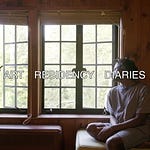Want to apply for artist residencies but not sure where to start? In this video, I explain what residencies are, why they’re valuable, and how to find and apply for them. I share my experience securing multiple residencies, tips for strong applications, and how to track opportunities. Whether you're a writer, musician, or visual artist, this is your sign to start applying!
Step 1: Research & Select the Right Residencies
Residencies come in many forms. Some provide stipends, lodging, and meals, while others offer an unpaid, immersive creative retreat. Begin by determining what you need: Do you require a quiet space to finish a project? Are you looking for opportunities that offer networking with other artists or even specialized support (childcare, accessibility, etc.)?
Tips:
Sign up for newsletters and browse curated residency directories.
Use digital tools to compile a list of opportunities that align with your practice and identity.
Resources:
Galleyway - Has a regular newsletter of residency opportunities
Res Artis – A global network and directory of artist residencies.
NYFA Residency Listings – Regularly updated opportunities across disciplines.
Step 2: Organize & Track Your Opportunities
With dozens of potential residencies out there, staying organized is key. Create a digital or physical system to log details for each residency—deadlines, location, application fee, required materials, and any special conditions related to your identity or art practice. Consistency is crucial; set aside dedicated time each week to update your list and schedule application sessions.
Tips:
Use tools like Notion, Google Sheets, or even a bullet journal to manage deadlines and track progress.
Bookmark or save newsletters that provide residency listings; even a quick glance can keep you informed.
Resources:
• Notion Templates for Application Tracking – Customize a template to keep your residency applications organized.
Step 3: Prepare Your Application Materials
Artist residency applications typically require several standard components: an artist biography, an artist statement, a work or project statement, and a portfolio (or work sample). This is your opportunity to present a cohesive, compelling narrative of your creative journey. Here’s how to refine each element for maximum impact:
1. Artist Biography
What to Include:
Background & Milestones: Summarize your artistic journey, key achievements, and significant projects or residencies. Be sure to include clear dates and a sense of timeline.
Unique Perspective: Highlight what sets you apart—whether it’s your cultural background, your influences, or your personal mission.
Expert Tips:
Keep it Updated: Regularly review and refine your bio to incorporate recent projects, awards, or residencies.Try to update this 1-2 times a year.
Tailor for Each Residency: If a residency has a specific focus (e.g., community art, experimental writing, socially engaged practices), adjust your bio to emphasize relevant experiences.
Concise & Engaging: Aim for clarity and brevity; your bio should be engaging but not overly long.
Resources:
• Guide to Writing an Artist Statement (while focused on artist statements, it offers insight into personal narratives that work well in bios)
• NYFA Artist Residency Resources – Check out their articles and webinars on crafting compelling bios.
2. Artist Statement
What to Include:
Creative Vision: Describe your practice, the themes you explore, and the techniques you use. Did you learn certain techniques through
Artistic Intent: Explain the “why” behind your work—what drives you, what impact you hope to have, and how your practice connects to broader cultural or social conversations. Why do you make the art that you do? What events in your life have influenced your practice?
Expert Tips:
Show, Don’t Tell: Use concrete examples from your work to illustrate your ideas.
Revise & Solicit Feedback: Write drafts, share them with trusted peers or mentors, and be open to constructive criticism.
Consistency: Ensure the tone and content of your artist statement align with the rest of your application materials.
Resources:
• How to Write an Artist Statement – A detailed guide with examples.
3. Work/Project Statement
What to Include:
Clear Objectives: Outline what project you plan to work on during the residency.
Timeline & Methodology: Describe your intended approach, techniques you’ll employ, and a rough timeline for your project milestones.
Residency Fit: Explain how this project fits with the residency’s goals or themes.
Expert Tips:
Be Specific: Detail your project so that reviewers understand the depth and feasibility of your plan.
Align with Residency Values: Research the residency’s ethos and mention how your project contributes to or benefits from that context.
Proof of Concept: If possible, include examples of past work or preliminary sketches that hint at your project’s potential.
4. Portfolio/Work Sample
What to Include:
Best Work: Select pieces that showcase the breadth and depth of your practice, highlighting recent and impactful projects.
Diversity & Cohesion: Ensure your portfolio has variety but also tells a cohesive story about your artistic identity.
Expert Tips:
Curate Thoughtfully: Limit your selection to work that is relevant to the residency’s focus. Quality trumps quantity.
Digital Presentation: If submitting online, make sure files are high resolution and formatted correctly.
Feedback & Iteration: Regularly update your portfolio based on feedback from mentors, peers, or professional reviews.
Resources:
• Submittable – Many residencies use this platform for portfolio submissions; explore their guidelines and best practices.
Step 4: Tailor, Submit & Follow Up
Now that your materials are polished and your opportunities are organized, it’s time to start applying. Customize your application for each residency, emphasizing how your current projects and artistic goals align with their mission. After submission, track your applications, note when you applied, and schedule follow-up dates if needed. Rejections are part of the process—each “no” is one step closer to a “yes.”
Tips:
Consider reaching out to residencies if you have questions or need fee waivers—many are open to discussion, especially for underrepresented or economically challenged artists.
Save copies of every application version; you may be able to repurpose successful elements in future submissions.
Resources:
• CERF+ Emergency Relief for Artists – Explore financial assistance options to support your application journey.
Step 5: Invest in Your Future as an Artist
Applying to residencies is more than just filling out forms—it’s an investment in your creative journey. With every application, you’re building your portfolio, refining your narrative, and opening doors to new experiences. As you cast a wide net, remember that each rejection is a learning opportunity, and each acceptance is a potential adventure that can reshape your art and practice.
Final Thought:
Every step you take—from researching and organizing opportunities to perfecting your application materials—builds the foundation for a vibrant artistic future. Start now, be persistent, and embrace the adventure that comes with each residency opportunity.










